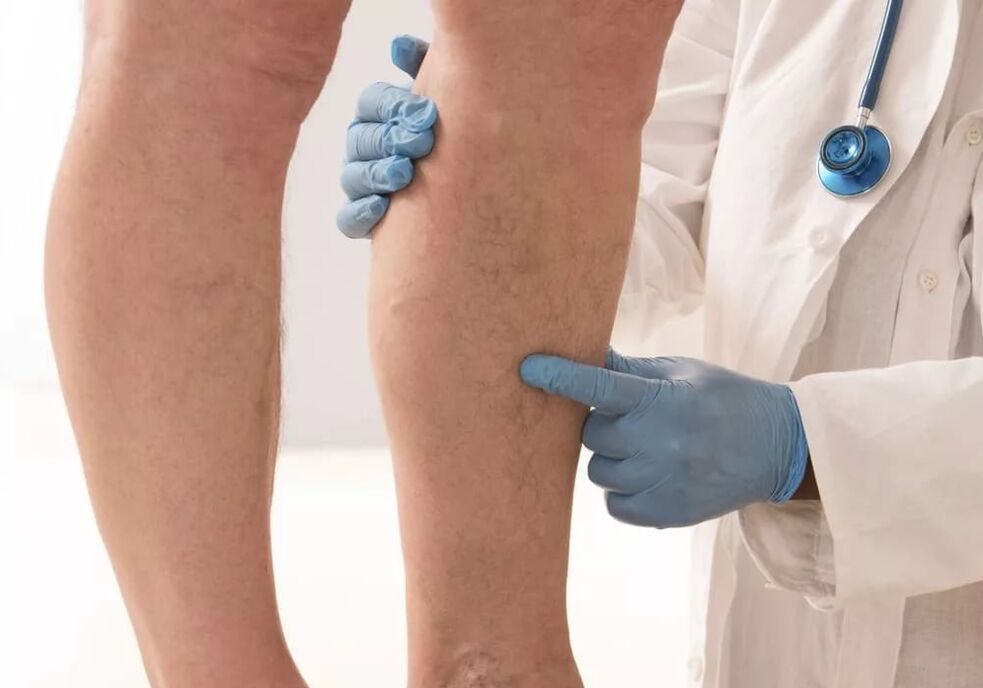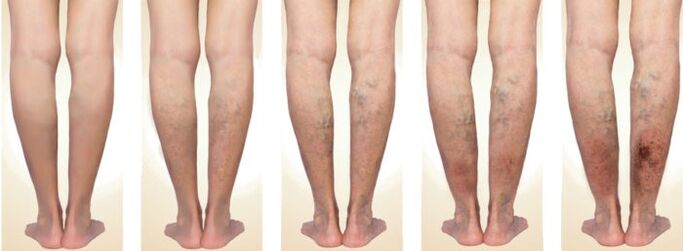Varicose veins, or varicose veins, are pathological changes in the veins, accompanied by their saccular expansion, increase in length, formation of convolutions and nodular tangles, which leads to valvular failure and impaired blood flow. Varicose veins are one of the most common blood vessel problems.

What are varicose veins?
Varicose veins are a pathology of the veins, which is based on a violation of the valvular apparatus of blood vessels with the formation of venous insufficiency, expansion of the lumen, congestion, which are accompanied by constant pastosity of the tissues.
The main causes of pathology
Varicose veins in the legs have different causes and symptoms that have slight gender differences. The main common trigger of the pathology is called congenital connective tissue weakness. Secondly, hormonal changes, so women are more often diagnosed with varicose veins. A long static sitting or standing position plays a role, while the longer the legs, the more serious the situation. Extra pounds also cause increased pressure in the veins of the lower extremities, as well as lack of physical activity. Smoking, pregnancy, concomitant pathologies, tight underwear, shoes, heels, anything that causes stagnation of blood circulation in the veins of the legs are risk factors for varicose veins.
Symptoms and clinical manifestations
Signs of varicose veins in the legs in women and men have no fundamental differences. This is a staged disease, the symptoms of which correlate with the stage of development of the pathological process.

The first stage is characterized by minor clinical manifestations: the veins barely protrude above the surface of the skin, the dermis is slightly hyperemic, heaviness in the legs, night passosity of the legs and ankles begins to bother, convulsions are possible. Such symptoms of varicose veins are especially painful for women from an aesthetic point of view. Visual signs are often preceded by pain.
At the second stage, the clinical picture acquires a typical appearance: the veins of the legs protrude in relief above the surface of the skin, are well palpable and resemble knots. If the pathological process progresses, the veins of the lower extremities acquire tortuous shapes, a blue-violet hue, sometimes they turn black.
Symptoms of varicose veins of the legs of the third stage are characterized by the development of complications: trophic disorders appear, the skin looks like parchment, swelling and cramps become common, the legs become covered with a rash, begin to itch, secondary flora joins, pyoderma layers, dermatitis, eczema.
The fourth stage of lower extremity varicose veins is the most severe in terms of symptoms: the skin above the protruding veins becomes inflamed, nearby tissues are involved in the process, trophic ulcers open, pain in the legs withvaricose veins is permanent, the addition of a secondary infection causes thrombosis, thrombophlebitis, urgent hospitalization is required, complex treatment.
Which doctor should I contact?
Leg pain with varicose veins is managed by a phlebologist, but a vascular surgeon can also make an initial appointment. It all depends on the severity of the pathology. The phlebologist prescribes conservative treatment or refers to a consultation with a vascular surgeon to decide on the operation.
Without a complete clinical and laboratory examination, it is not possible to make an accurate diagnosis. Instrumental diagnostic methods help to clarify the stage of the pathology, the duration of the tests takes 10 minutes, a maximum of half an hour. The result of the examination is announced by the doctor immediately, during the first appointment. The choice of adequate treatment depends on the stage of the pathology.
Treatment characteristics
The therapy of varicose veins is based on the "three pillars": drug treatment, minimally invasive techniques, conventional surgery.
Conservative therapy
In addition to the general mandatory recommendations for varicose veins: dosed and regular physical activity, minimization of static load on the legs, exercise therapy, wearing compression stockings, using elastic bandages - conservative therapy involves the appointment of phlebotonicsbased on diosmin and hesperidin flavonoids, horse chestnut extract.
Most often, ingestion is combined with the external therapy of the same name for varicose veins. According to doctors and patients, the combination of capsules and gel is the most effective.
Of course, full recovery should not be expected from conservative methods, drugs are not able to restore dilated veins, but as a preventive measure, in preparation for surgery, the impossibility of surgical treatment ofvaricose veins - these drugs guarantee a halt in the progression of the disease and relieve symptoms.
Compression sclerotherapy
The essence of a minimally invasive technique for the treatment of varicose veins is the introduction of a special sclerosing drug into the dilated vein. Using a syringe, the doctor injects a foamy solution into the vein, which fills the deformed vessel, spasming it.
The patient is put on a compression stocking, which is designed to keep the vessel in this state. In three days, the walls of the veins stick together, the vessel is cut off from the usual blood flow and empties. You should wear compression stockings for at least a month, sometimes two. Criteria for the effectiveness of treatment - formed adhesions.
Compression sclerotherapy is performed if varicose veins are not complicated by reverse blood flow from deep vessels to superficial vessels through communicating veins. If such reflux is present, the effectiveness of the procedure tends to zero.
Operation
Surgery has been and remains the most reliable and effective way to treat varicose veins, regardless of the presence of reverse blood flow in the veins. But even in this case, it is important to consult a doctor in time, since relapses often occur at later stages. Varicose veins are operated on with different techniques: microsurgery, radiofrequency and laser coagulation of deformed veins.
In the early stages, photocoagulation or removal of varicosities with a laser is effective. At later stages, phlebectomy is indicated - the complete removal of the affected veins. The operation is traumatic, there is a risk of complications, which is why today doctors are trying to use the technique of less invasive miniphlebectomy. If varicose veins are complicated by venous thrombosis, secondary infection, an operation is performed.
What can be done with varicose veins of the legs at home?
The essence of using folk remedies for the prevention and treatment of varicose veins is to remove toxins from the body with the restoration of normal blood flow. To do this, balance the diet, including cabbage, tomatoes, peppers, green vegetables, citrus fruits, apples, peaches, cherries, cherries, strawberries, currants and currants in mealsdailies. Be sure to calculate the correct diet: 40 ml per kilogram of weight.
In addition, the properties of green tomatoes are used, which are tied in slices to the varicose vein zone in the form of compresses. The effect is guaranteed by lycopene - an antioxidant in the pulp of the fruit, which improves the structure of the vascular wall, tones the veins. You can try the juice cure: all vegetables that are eaten raw are suitable.
Apple cider vinegar is popularly considered a source of minerals and vitamins; for varicose veins, it is taken orally in the morning and in the evening, dissolving two teaspoons of the product in a glass of water. Externally: wipe the varicose veins with a cotton swab soaked in vinegar to relieve itching and pain.
Compresses are made with honey, applying a sterile napkin with the product to the area of varicose veins for a couple of hours under the film. Use cabbage leaves beaten with vegetable oil under a bandage at night. The course is one month.
Prevention
The prevention of varicose veins has two objectives: to prevent the onset of the disease and to reduce the number of relapses. To do this: you can not go to the sauna or take too hot baths, lift weights. It is recommended to move a lot, excluding strength sports, to control weight, to minimize the consumption of too spicy and fatty foods.
No need to wear tight clothes, socks, socks, stockings with tight elastic, cross your legs while sitting. Women are encouraged to forgo high heels.
At night - take cool foot baths, you can pour cold water on your feet in the morning. It is necessary to give up bad habits, master acupressure: caress the skin of the lower limbs from bottom to top and in the opposite direction for 10 minutes, minimize stress, avoid overheating, colds, pass a medical examination.
With varicose veins, it is reasonable to go swimming, walk, take a contrast shower at home and constantly wear compression stockings.

















